2024..01.01.65
Files > Conference Series > 2024 > Chimboazo ild pagina nueva
Incidence of Vibrio parahaemolyticus Coryphaena Hippurus (dorado fish) and Thunnus alalunga (albacore fish) sold in high-demand markets in Guayaquil City
Aura Hidalgo1*, Melissa León1, Enrique Salazar Llorente2, María Gabriela Maridueña- Zavala3 and Juan Cevallos Cevallos3,4
1Facultad de Ingeniería Mecánica y Ciencias de la Producción, Escuela Superior Politécnica del Litoral, Guayaquil, Ecuador.
2Facultad de Ciencias Agropecuarias, Universidad Técnica de Babahoyo, Km 7.5 Vía Babahoyo – Montalvo, Ecuador.
3Centro de Investigaciones Biotecnológicas del Ecuador, Escuela Superior Politécnica del Lito-ral, Guayaquil, Ecuador.
4Facultad Ciencias de la Vidas, Escuela Superior Politécnica del Litoral, Km 30.5 Vía Perimetral, P.O. Box 09-01-5863, Guayaquil, Ecuador
Available from. http://dx.doi.org/10.21931/BJ/2024.01.01.65
ABSTRACT
Foodborne diseases affect around 600 million people in the world. In Ecuador, the Ministry of Public Health (MSP) reported 12,203 cases of food poisoning caused mainly by Salmonella species, hepatitis virus or other pathogenic microorganisms in 2019. However, there are no reports of diseases caused by Vibrio species in Ecuador. The present study assessed the presence of V. parahaemolyticus, mesophilic aerobics, total coliforms and E. coli. Samples of Coryphaena hippurus (dorado fish) and Thunnus alalunga (albacore fish) in 3 different markets in the city of Guayaquil, Ecuador. As a result, Vibrio parahaemolyticus was not found in any of the 60 samples analyzed. In contrast, the E. coli levels met the requirements established in the INEN 183 - 2013 Standard norm. All samples from Market 1 were within the acceptance range regarding mesophilic aerobic levels. However, high mesophilic aerobic levels were obtained in 60% of the albacore samples and 50% of the dorado samples from this market. In the same way, 40% of the albacore and 100% of Dorado samples from market 3 were high in mesophilic microorganisms. However, the mesophilic aerobic analyses revealed safer levels in samples from market 1 than in markets 2 and 3, according to the NTE INEN. 183:2013.
Keywords: Foodborne diseases, fish, Albacore, E coli, mesophilic aerobics, Dorado.
INTRODUCTION
According to the WHO, one thousand five hundred million cases of diarrheal diseases are reported every year and three million children under the age of five die in the world due to the intake of contaminated food 1 . It is currently known that in products from the sea, the presence of the Vibrio parahaemolyticus bacterium has been identified worldwide as an essential cause of disease outbreaks and transmitted by food or ETAs 2 . This pathogen is the leading cause of gastroenteritis transmitted by seafood 3 . They have not had inadequate cooking or suffered contamination during preparation or non-compliance with the cold chain during transport that favors the proliferation of the bacteria 4. Vibrio parahaemolyticus is a Gram-negative bacterium that is spread through food and can cause mild illness with a medium-high probability of mortality in individuals with weak immune systems 5. Different strains are known to cause cases of acute gastroenteritis in humans, with foodborne transmission being one of the most common forms. Seafood is considered one of the primary sources of these bacteria 6. According to recent information, Vibrio parahaemolyticus is one of the most critical emerging pathogenic microorganisms in food and is currently a significant concern in the food industry 7.
In 1950, 20 people died, and 270 were hospitalized in Japan from eating contaminated sardines. Between 1973 and 2006, 45 outbreaks of ATS caused by seafood were recorded, with 1,393 cases and 24 hospitalizations in the United States 8 . Likewise, four outbreaks were reported by the European Food Safety Authority (EFSA) in 2015 in France. In two outbreaks, the consumption of crustaceans, mollusks and their products was suspected 9 . Because of the high number of hospitalized and deceased patients (20-30%), various regulatory agencies, such as the U.S. Food and Drug Administration (FDA), have adopted a zero-tolerance policy for the presence of L. monocytogenes in foods prepared for direct consumption (RTE) 10. In addition, it has been possible to identify that inadequate post-capture handling of shellfish increases the risk of incorporation of other pathogenic microorganisms such as Salmonella spp, Listeria monocytogenes, Aeromonas hydrophyla, Shigella ssp, among others. Quantifying indicator microorganisms such as mesophilic aerobics, coliforms, and E. coli provides an idea of the level of post-harvest contamination of shellfish 11 . These categories are used as a precautionary measure before harvesting to detect when to limit harvesting and to decide whether post-harvest treatments are required 12. An evaluation of three different commercialized fish species (boquichico, pomfret and catfish) in the port of Pucallpa, Ucayali, Peru, identified contamination in food by E. coli and V. parahaemolyticus 13 . The Escherichia coli tests were not compliant and are used to monitor how antimicrobial resistance and sensitivity trends evolve 14. In this way, the importance of studies on the prevalence of pathogens in food is demonstrated as an initial step to determine the risks associated with their consumption.
Ecuador has a high demand for shellfish, which can bring gastrointestinal diseases when eaten raw or undercooked. Currently, no known pathogenic microorganisms in Ecuador are associated with Coryphaena hippurus (dorado) and Thunnus alalunga (albacore) fish, which are the most consumed nationwide. Recent investigations of the microbiological quality of 450 samples of foods in high demand in Guayaquil, Quito, and Cuenca, such as bolón, onion, sauces, ceviche, fruit, fruit juice, fruit salad, cheese, raw chicken, and ground beef. The country's popular street markets identified levels of total mesophilic aerobic, total coliform, fecal coliform, and bacteria such as Escherichia coli, Salmonella enterica, and Listeria monocytogenes in food. The result of the study was a high prevalence of Salmonella, L. monocytogenes, and various opportunistic pathogens, which indicates a risk of microbiological contamination of foods sold in mass markets 15 16 . However, the study did not contemplate a microbial evaluation of the fish sold in the markets. In foods such as fish, the high content of water and nutrients such as proteins, fats, vitamins and minerals, together with a pH close to neutral and warm temperatures, create an ideal environment for the rapid growth of bacteria 17. The absence of this information prevents knowing the biological risks associated with shellfish consumption in Ecuador and makes it difficult to develop training strategies on post-harvest shellfish handling. Although microbiological tests are carried out to identify whether dangerous microorganisms are present in seafood products, they are not always carried out 18.
The purpose of this study was to determine the presence of Vibrio parahaemolyticus and safety indicator microorganisms in Coryphaena hippurus (dorado) and Thunnus alalunga (albacore) fish samples through traditional microbiological analysis (total mesophilic aerobes, total coliforms and E. coli ) at to evaluate the risk of microbial contamination of these seafood products in three high-demand markets in the city of Guayaquil.
MATERIALS AND METHODS
Sample collection
Samples of each fish species were obtained from three crowded markets in Guayaquil (markets 1, 2 and 3). The sample size was estimated following the classification of "sampling plans with the type of concern and danger" according to the Codex Alimentarius 19, which indicates many samples (n) of 10 and a maximum number allowed for the presence of the pathogen. (c) from 0 20 . Thus, 60 random samples were taken, divided into 10 albacore samples and 10 dorado samples for each market. The sampling was carried out during May and June 2021 using polyethylene bags. The temperature was obtained using an AMPROBE IR-712 12:1 digital thermometer when obtaining the samples. After this, the samples were placed in a cooler (polyurethane container) with ice and transported to the laboratory.
Microbiologic analysis
To quantify indicator microorganisms, 25 grams of each sample were taken aseptically, and 225 ml of phosphate buffer was added. Subsequently, serial dilutions were made before inoculation in PCA medium ( Plate count Agar), and Petrifilm Total Coliforms/ E. coli slides. Subsequently, the Petri dishes and the petrifilm sheets were incubated for 48 hours at 35°C. All PCA and petrifilm colonies were enumerated, while gas-blue colonies on petrifilm were counted as E. coli 21 . To determine V. parahaemolyticus, the sample was homogenized, and a 25-gram aliquot was suspended in 225 ml of alkaline peptone water (APA). Subsequently, the suspension was incubated at 35 ± 2°C for 18 to 24 hours. After the incubation, seeding was carried out by spreading on TCBS agar (thiosulfate-citrate-bile salts-sucrose) followed by incubation at 35°± 2°C for 18 to 24 hours. After the mentioned time, typical Vibrio colonies were searched for. parahaemolyticus, considering the morphological characteristics such as turquoise green, shiny, smooth, and flattened strains with a green or blue center. After incubation, the oxidase test was performed to inoculate an aliquot of the previous culture with AP 0%, 3%, 6%, 8%, and 10% 22 23.
Statistical analysis
This study defined the counts of V. parahaemolyticus, mesophilic aerobics, total coliforms, and E. coli as the response or dependent variables. At the same time, the type of fish and market were considered independent variables. For the statistical analysis, the Minitab version 17 statistical software was used 24 , with the two-way ANOVA statistical tool to measure the effect of the fish species, the market, and the species-market interaction on the response variables. For individual comparisons, Tukey's pairwise comparison test was applied 25 . Given the selected sample size, 95% confidence level and normality assumptions were used for the analyses.
RESULTS
Sample temperature
The fish samples showed bright eyes, shiny scales, red gills, firm meat, and a characteristic smell of the sea, indicating that the products were fresh and without signs of decomposition 26 . The temperatures recorded in degrees Celsius (°C) obtained during the sampling are those detailed in Table 1. A higher product storage temperature is observed, which varies between 6 to 7°C in Markets 2 and 3 and temperatures ranging from 1°C to 3°C for Market 1.
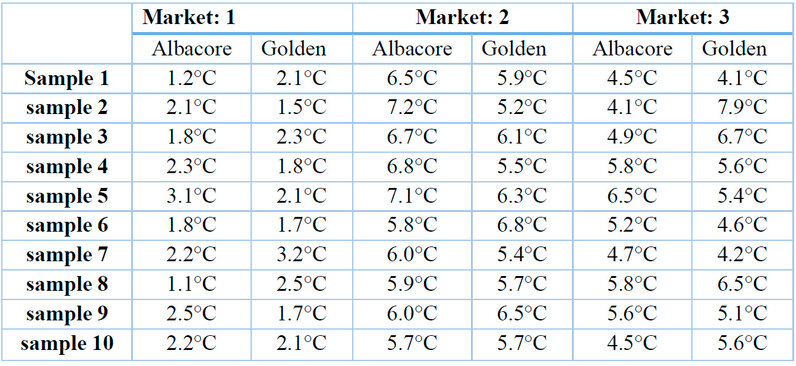
Table 1: Temperatures of the fish samples were taken in the three different markets of the city of Guayaquil.
In this investigation, 60 samples of albacore and mahi-mahi fish were analyzed to identify the presence of microorganisms that cause illnesses due to food intake, such as total aerobic, total coliforms and Vibrio parahaemolyticus. Initially, regarding the temperatures of the samples, we observed that in market 1, they were the lowest at the time of sampling with an average of 2.06 °C, unlike markets 2 and 3, where their average temperatures were 6.14 and 5.37 °C, respectively. However, this factor did not influence the greater or lesser presence of microorganisms, especially in Vibrio, evidence that agrees with what has been reported in other studies where it was shown that temperature fluctuations during transportation and storage of shellfish may be less critical. for fish than for raw oysters, mainly because V. parahaemolyticus did not show significant growth in fish samples until after four hours at 25°C 27.
Microorganism count
Vibrio parahaemolyticus
Regarding the presence of the pathogen, the presence of V. parahaemolyticus was detected in none of the samples analyzed. These results were also observed in Peru in the port of Pucallpa, Ucayali, in which this pathogen was not detected in shellfish samples 28 . In the same way, other studies suggest that the flora of microorganisms present in fish samples can make it difficult to isolate the pathogen 29, so it is always recommended to update the isolation protocols 30. Based on this and the data obtained, the research results suggest that the dorado and albacore species are not essential reservoirs of this pathogen, which has been confirmed using PCR techniques (Polymerase Chain Reaction ) for the detection of Vibrio in samples of golden fish in Mercados de La Libertad, in which the absence of the pathogen for this type of fish was confirmed, corroborating the results of the investigation and suggesting that its appearance may be limited to species such as Jurel, Lisa 31 and Silverside like those found in Peru 32 or species like Picudo reported in Ecuador.
Aerobic mesophiles
6 CFU/g was counted and compared to the Albacore samples with 45 x 10 4 CFU/g. In general, mahi-mahi samples had significantly higher mesophilic aerobic levels than albacore samples. Likewise, the amount of aerobes on average differed significantly between markets 1 (45 x 10 4 CFU /g) and markets 3 (45 x 10 5 CFU /g) and 2 (80 x 10 4 CFU/g). In markets 1 and 2, it was observed that there are no significant differences in the levels of mesophilic aerobics, and it was observed that the lowest average levels of aerobics occur in market 1.
Figure 1 shows the means and standard error of mesophilic aerobics obtained by market and species.
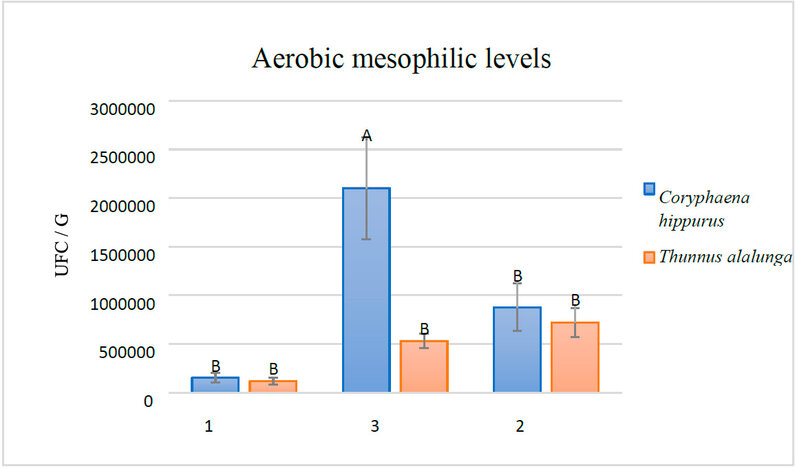
Figure 1: Values of aerobic mesophiles found in Coryphaena hippurus (dorado) and Thunnus alalunga (albacore) in three markets in Guayaquil. Different letters represent significant differences (p ≤ 0.05).
Tukey's comparison between the response variable, quantity of aerobics, and the interaction between the qualitative factors of species-market type showed that the levels of mesophilic aerobics in dorado fish from market 3 were significantly higher (21 x 10 5 CFU/g) than those found in the other samples analyzed. Likewise, the two-way ANOVA showed that the number of aerobes did not differ statistically between the interactions of Dorado-market 2, Albacora-market 2, Albacora-market 3, Dorado-market 1, and Albacora-market 1 (Table 2).

Table 2: Mesophilic aerobes observed in the different species-market interactions. Different letters represent significant differences (p ≤ 0.05).
Total coliforms
With the results obtained, it can be seen that the amount of total coliforms on average differs significantly between market 2 (8.26 x 10 2 CFU/g) and markets 3 (2.4 x 10 3 CFU/g) and 1 ( 4 x 10 2 CFU/g). There were no significant differences in these last two markets. The highest average amount of total coliforms was observed in market 2. Figure 2 shows the averages and standard error of the total coliforms found in each sample.
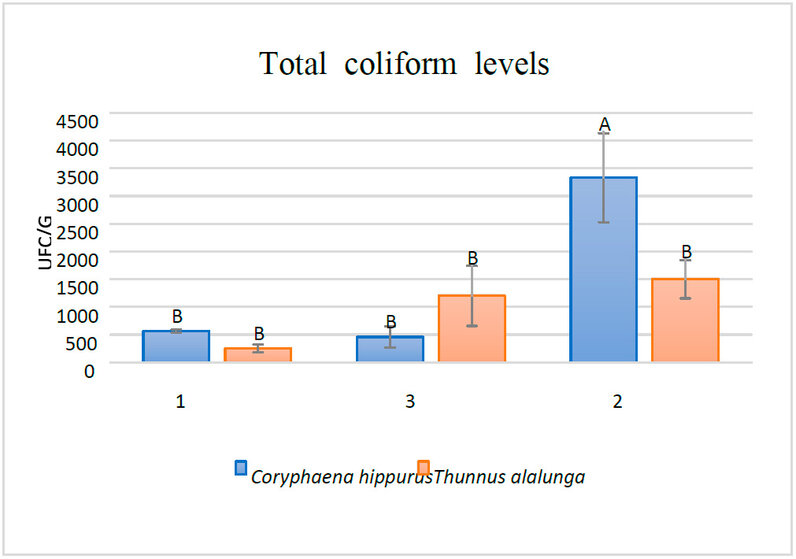
Figure 2: Values of total coliforms found in Coryphaena hippurus (dorado) and Thunnus alalunga (albacore) in three markets in Guayaquil. Different letters represent significant differences (p ≤ 0.05).
Additionally, Tukey's pairwise comparison test was used to statistically determine which factor or factors have a significant effect on coliform levels. Applying ANOVA of two factors, it was determined that there are significant differences (p ≤ 0.05) in the total coliforms of the market factor and the species-market interaction. For the factor corresponding to the species, no significant effect was found on total coliform levels.
Likewise, it was observed that the Dorado fish from Market 2 presented significantly higher levels of total coliforms than the other fish analyzed. Likewise, it can be concluded that the number of total coliforms did not differ statistically between the interaction of Albacora-market 2, Albacora-market 3, Dorado-market 1, Dorado-market 3, and Albacora-market 1, as shown in Table 3.
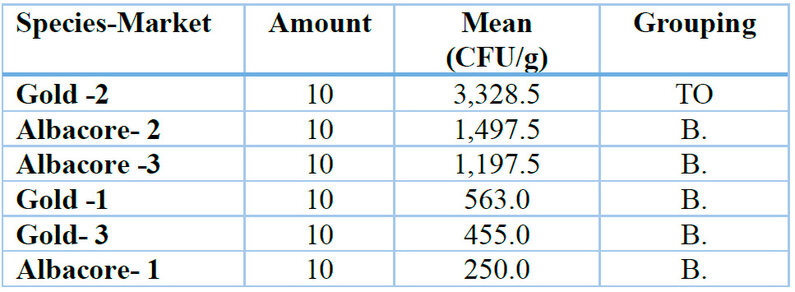
Table 3: In comparing the Tukey test of total coliforms between the species-market response variable in the evaluated markets of Guayaquil, different letters represent significant differences (p ≤ 0.05).
E. coli
Figure 3 shows the averages and standard error of the E. coli levels found in each sample; a higher amount of CFU/g is observed in the Coryphaena samples—hippurus (golden).
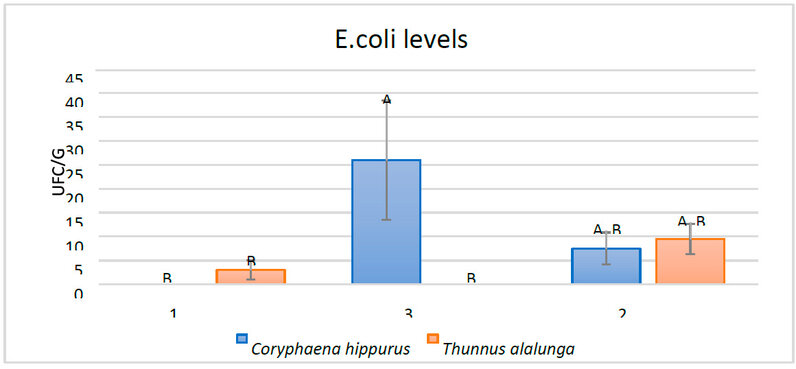
Figure 3: Values of Escherichia coli found in Coryphaena hippurus (dorado) and Thunnus alalunga (albacore) in three markets in Guayaquil. Different letters represent significant differences (p ≤ 0.05).
Applying ANOVA of the general linear model with two factors, it was observed that only the interaction of the type of species and market showed a significant effect (p ≤ 0.05) on the levels of E. coli.
The E. coli levels of the interaction of the type of Dorado species from Market 3 were significantly higher than the levels of this microorganism in all the fish species from Market 1. Likewise, it was observed that the levels of E coli in the fish of both species from market 2 did not differ significantly from those observed in the fish of both species from the other markets, as shown in Table 4.

Table 4: In comparing the E. Coli Tukey test between the species-market response variable in the evaluated markets of Guayaquil, different letters represent significant differences (p ≤ 0.05).
DISCUSSION
In this investigation, the levels of aerobic mesophiles in gold-type fish from market 3 had an average count of 21.0x10 5 CFU/g, with a 95% confidence interval between 9.18x10 5 and 32.8x10 5 CFU/g. Therefore, according to the BAM 2001 reference method, they are outside the requirement established by the Ecuadorian Technical Standard NTE INEN 183:2013, which is between 5x10 5 and 10x10 5 CFU/g. These results are comparable with the study carried out in Peru in which the total aerobic samples were higher than those specified in the SANIPES (2016a) standard. Likewise, the values coincide with those reported 33 in samples of golden fish in a study in Mercado municipality of Cantón Chone for microbiological identification, reporting high levels of mesophilic aerobics 34 . The results suggest foods handled in poor conditions and not stored at the proper temperatures. Additionally, the levels of E. coli and coliforms were within what was allowed, according to the reference method AOAC 21, 991 -14, in all the samples analyzed. These results suggest the absence of fecal contamination while handling the different fish species.
The samples of both species from market 1 had the lowest levels of aerobes. The average aerobic count was 13.0x10 4 CFU/g, with a 95% confidence interval between 7.09x10 4 CFU/g and 19.8x10 4 CFU/g. Therefore, according to the BAM 2001 reference method, there are within the established norm for both species studied. In the case of total coliforms, the average of both species in market 1 was 40.6 x 10 1 CFU/g, and the albacore species in this market had the lowest levels of coliforms, possibly due to better control of the supply chain—cold and high demand for this species.
CONCLUSIONS
The present study to detect V. parahaemolyticus in albacore and mahi-mahi fish species sold in three of the busiest markets in the city of Guayaquil represents an essential step to knowing the state of food safety in the country. The results showed no presence of this bacterium in the samples analyzed, so these fish species would not be important reservoirs of the pathogen. Regarding the study of detection of indicator microorganisms, such as total aerobic, total coliform and E. coli, significant effects were observed between market factors and fish species.
For total aerobes, there was no significant difference between markets 1 and 2 for both fish species. The dorado species from market 3 presented a higher average amount of mesophilic aerobics than both species from the other markets. No significant differences were observed in the aerobic levels of the albacore species in all markets.
For total coliforms, it can be concluded that there were no significant differences in total coliform levels between the albacore and dorado species from markets 1 and 3. The Dorado species from Market 2 presented significantly higher coliform levels than the other markets. And species. No significant differences were observed in the coliform levels of the albacore species in all markets.
For E. coli, it can be concluded that the Dorado species from market 3 had a significantly higher amount of E. coli than the albacore species from the same market and that both species from market 1. No significant differences were observed in the levels of E. coli of the albacore species from all markets. No significant differences were observed when comparing the levels of E. coli between markets 3 and 2 or 1 and 2 in both species.
Generally, the lowest levels of the microorganisms analyzed were observed in market 1 in both species.
REFERENCES
1. Soto Varela, Z., Pérez Lavalle, L. and Estrada Alvarado, D. (2016) 'Bacteria that cause foodborne diseases: a look at Colombia, 'Salud Uni3 , 32(1), pp. 105–122
2. Scott, B. (2015) Analysis of the Ecuadorian Fishing Sector after Dollarization. San Francisco de Quito University.
3. Franco- Monsreal, J., Lara-Zaragoza, EB, Villa-Ruano, N., Mota-Magaña, L., Del, LE, Serralta-Peraza, S., Cuevas-Albarrán, V., Sosa-Castilla, F. and Monsreal, JF (2014) Clinically essential species of the genus Vibrio in seafood of animal origin from establishments in Puerto Ángel, Oaxaca, Mexico.
4. Soto Varela, Z., Pérez Lavalle, L. and Estrada Alvarado, D. (2016) 'Bacteria that cause foodborne diseases: a look at Colombia, 'Salud Uni3 , 32(1), pp. 105–122
5. Ryser ET. Chapter 11 - Listeria. En: Morris JG, Vugia DJ, editores. Foodborne Infections and Intoxications (Fifth Edition) [Internet]. Academic Press; 2021 [citado 2 de abril de 2023]. p. 201-20. Disponible en: https://www.sciencedirect.com/science/article/pii/B9780128195192000281
6. Mashak Z, Banisharif F, Banisharif G, Reza Pourian M, Eskandari S, Seif A, et al. Prevalence of Listeria Species and Serotyping of Listeria monocytogenes Bacteria Isolated from Seafood Samples—Egyptian Journal of Veterinary Sciences. 1 de abril de 2021;52(1):1-9.
7. Bolívar A, Garrote Achou C, Tarlak F, Cantalejo MJ, Costa JCCP, Pérez-Rodríguez F. Modeling the Growth of Six Listeria monocytogenes Strains in Smoked Salmon Pâté. Foods. enero de 2023;12(6):1123.
8. Achipia. Risk Analysis Support Area (2017) Vibrio parahaemolyticus .
9. European Food Safety Authority (2016) The European Union summary report on trends and sources of zoonoses, zoonotic agents and foodborne outbreaks in 2015 , EFSA Journal . John Wiley and Sons Inc. Available at: https://doi.org/10.2903/J.EFSA.2016.4634 .
10. Basha KA, Kumar NR, Das V, Reshmi K, Rao BM, Lalitha KV, et al. Prevalence, molecular characterization, genetic heterogeneity and antimicrobial resistance of Listeria monocytogenes associated with fish and fishery environment in Kerala, India. Letters in Applied Microbiology. 1 de octubre de 2019;69(4):286-93.
11. Alejandra González (2017) Consuming raw fish and shellfish. Is it safe for health? , http://www.ideafoodsafetyinnovation.com/news/2017/09/index.html .
12. Gyawali P, Fletcher GC, McCoubrey DJ, Hewitt J. Norovirus in shellfish: An overview of post-harvest treatments and their challenges. Food Control. 1 de mayo de 2019;99:171-9.
13. Rondón , JE, Ramos, DD, Vilca , ML, Salazar, ES, Mendoza, YQ and González, R. v. (2020) 'Sanitary characterization and identification of microbial contamination points in the fishing marketing chain in the port of Pucallpa, Ucayali, Peru', Revista de Investigaciones Veterinarians of Peru , 31(1). Available at: https://doi.org/10.15381/rivep.v31i1.17539 .
14. Hidalgo-Sindoni M. Seasonal trends and sampling time of day on overall microbial population and indicator organisms in catfish parts and catfish processing environment. Theses and Dissertations [Internet]. 9 de diciembre de 2022; Disponible en: https://scholarsjunction.msstate.edu/td/5651
15. Cevallos, JM, Ruales , J., Ortiz, J. and Maldonado, P. (2019) 'Advances in biosciences and food safety in Ecuador', pp. 1–127.
16. Salazar- Llorente , E., Morales, M., Sornoza , I., Mariduena-Zavala, MG, Gu, G., Nou , X., Ortiz, J., Maldonado-Alvarado, P. and Cevallos-Cevallos, JM (2021) 'Microbiological quality of high-demand food from three major cities in Ecuador ', Journal of Food Protection , 84(1), pp. 128–138. Available at: https://doi.org/10.4315/JFP-20-271 .
17. Cortés-Sánchez ADJ, Espinosa-Chaurand LD, Díaz-Ramirez M, Torres-Ochoa E. Plesiomonas: A Review on Food Safety, Fish-Borne Diseases, and Tilapia. Romalde JL, editor. The Scientific World Journal. 21 de septiembre de 2021;2021:1-10.
18. Spaur M, Davis BJK, Kivitz S, DePaola A, Bowers JC, Curriero FC, et al. A systematic review of post-harvest interventions for Vibrio parahaemolyticus in raw oysters. Science of The Total Environment. 25 de noviembre de 2020;745:140795
19. FAO. Revision of the code of practice for fish and fishery products (cxc 52-2003) and Revisions of the section on sampling, examination and analysis related to Histamine food safety [Internet]. Panama City, Panama: Codex Alimentarius Commission; 2018 nov p. 28. (Codex committee on food hygiene). Report No.: Agenda Item 6. Disponible en: https://www.fao.org/fao-who-codexalimentarius/sh-proxy/fr/?lnk=1&url=https%253A%252F%252Fworkspace.fao.org%252Fsites%252Fcodex%252FMeetings%252FCX-712-50%252FWD%252Ffh50_06_add1s.pdf
20. Ecuadorian Institute for Standardization (2014) GENERAL GUIDELINES ON SAMPLING (CAC/GL 50-2004, IDT) . quit.
21. Maturrin , L. and Peeler, JT (2001) Laboratory Methods (Food) . Available at: https://www.fda.gov/food/laboratory-methods-food/bam-chapter-3-aerobic-plate-count#conventional (Accessed: January 22 2023).
22. Kaysner , CA, DePaola , A. and Jones, J. (2004) Bacteriological Analytical Manual (BAM) . Available at: https://www.fda.gov/food/laboratory-methods-food/bam-chapter-9-vibrio (Accessed: January 22 2023).
23. Kaysner , CA, DePaola , A. and Jones, J. (2019) Bacteriological Analytical Manual (BAM) . FDA.
24. Arend , D.N. (2010) 'Minitab 17 Statistical Software'. State College .
25. Montgomery, DC (2003) Design and analysis of experiments . Limousa Wiley. World Health Organization (2001) Joint FAO/WHO Expert Consultation on Risk Assessment Associated with Microbiological Hazards in Foods .
26. Ecuadorian Institute for Standardization (2014) GENERAL GUIDELINES ON SAMPLING (CAC/GL 50-2004, IDT) . quit.
27. López Hernández, KM, Pardío Sedas, V. trinidad, Flores Primo, A., Martínez Herrera, D. and Uscanda Serrano, R. (2022) 'Estimation of the microbiological risk associated with the consumption of raw oysters contaminated with Vibrio cholerae and Vibrio parahaemolyticus ', Journal of Biological and Health Sciences , XXV(1), pp. 14–23. Available at: https://doi.org/10.18633/biotecnia.v25i1.1701 .
28. Rondón , JE, Ramos, DD, Vilca , ML, Salazar, ES, Mendoza, YQ and González, R. v. (2020) 'Sanitary characterization and identification of microbial contamination points in the fishing marketing chain in the port of Pucallpa, Ucayali, Peru', Revista de Investigaciones Veterinarians of Peru , 31(1). Available at: https://doi.org/10.15381/rivep.v31i1.17539
29. Váradi L, Lin Luo J, E. Hibbs D, D. Perry J, J. Anderson R, Orenga S, et al. Methods for the detection and identification of pathogenic bacteria: past, present, and future. Chem Soc Rev. 2017;46(16):4818-32.
30. Fernández Rendon, E., Nava Fernández, LM and Mota de la Garza, N. (1988) 'Absence of vibrio parahaemolyticus in raw fish / Abscence of vibrio parahemolyticus in raw fish ', Rev. latinoam . microbiol , 30(2)
31. Santistevan Magallán, AS (2020) Identification of Vibrio parahaemolyticus by PCR in dry-salted fishery products sold in the municipal market of La Libertad canton . Agrarian University of Ecuador.
32. Aliaga, R., Miranda, J. and Zevallos, J. (2010) 'Isolation and identification of Vibrioparahaemolyticus O3:K6 in fish and bivalve molluscs from a fish market in Lima , Peru.', Rev mid Inherited , 139.
33. Rondón , JE, Ramos, DD, Vilca , ML, Salazar, ES, Mendoza, YQ and González, R. v. (2020) 'Sanitary characterization and identification of microbial contamination points in the fishing marketing chain in the port of Pucallpa, Ucayali, Peru', Revista de Investigaciones Veterinarians of Peru , 31(1). Available at: https://doi.org/10.15381/rivep.v31i1.17539
34. Cedeño Mendoza, AL, Vargas Zambrano, PA, Talledo Solórzano, MV and Cuenca Nevárez, GJ (2021) 'The microbiological evaluation of fresh Albacore fish ( Thunnus alalunga ) in the Central Market of Cantón Chone', Revista de las Agrociencias, pp. 1–13.
Received: January 10, 2024/ Accepted: February 15, 2024 / Published:15 March 2024
Citation: Hidalgo A., León M., Salazar-Llorente E., Maridueña- Zavala M. G. and Cevallos-Cevallos J. Incidence of Vibrio parahaemolyticus Coryphaena Hippurus (dorado fish) and Thunnus alalunga (albacore fish) sold in high-demand markets in Guayaquil City. Revis Bionatura 2024; 1 (1) 65. http://dx.doi.org/10.21931/BJ/2024.01.01.65
Additional information Correspondence should be addressed to [email protected]
Peer review information. Bionatura thanks anonymous reviewer(s) for their contribution to the peer review of this work using https://reviewerlocator.webofscience.com/
All articles published by Bionatura Journal are made freely and permanently accessible online immediately upon publication, without subscription charges or registration barriers.
Publisher's Note: Bionatura stays neutral concerning jurisdictional claims in published maps and institutional affiliations.
Copyright: © 2024 by the authors. They were submitted for possible open-access publication under the terms and conditions of the Creative Commons Attribution (CC BY) license (https://creativecommons.org/licenses/by/4.0/).
